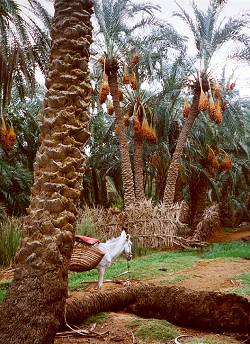
Eine natürliche Senke etwa 65 km südwestlich von Kairo. Sie umfaßt ein Gebiet von etwa 12000 Quadratkilometern. Sie ist die einzige Oase der westlichen Wüste, die mittels eines Nilarmes direkt mit Wasser versorgt wird. Ein Teil des Faijum besteht aus einem großen See, der in vorgeschichtlicher Zeit Salzwasser enthielt; dieser See ist nach und nach kleiner geworden und enthält jetzt Süßwasser. Im Altertum wurde das Faijum nach diesem See benannt: 'Ta-sche', 'Land des Sees '. Die koptische Übersetzung, 'Pa-yom', ist im modernen Namen noch enthalten. Bereits im Paläolithikum lebten hier Menschen (die frühesten Bewohner werden manchmal als Faijum B- und Faijum A-Gruppe bezeichnet), aber erst im Mittleren Reich (12. Dynastie, von Amenemhet I. an) wurde die Oase durch Einführung eines Wasserkontrollsystems mit Pumpen wirklich bewohnbar gemacht. Amenemhet III. ging das Problem in noch größerem Maßstab an, indem er bei el-Lahun eine Reguliervorrichtung erbauen ließ. Insbesondere während der 12. Dynastie, als die Residenz im nahegelegenen Lischt war, war das Faijum ein beliebtes Jagdgebiet. Diodor berichtet, daß der legendäre König Menes dort anscheinend jagte und von seinen eigenen Hunden angefallen wurde; er wurde von einem Krokodil gerettet und zum Dank baute er dem Krokodil ein Sanktuar und gründete die Stadt Schedit, die später zur Hauptstadt Krokodilopolis wurde; sowohl Herodot als auch Strabo besuchten die Stadt. In der Griechischen Zeit nannte Ptolemaios II. sie Arsinoe und die gesamte Region Arsinoites nach seiner Heirat mit seiner Schwester Arsinoe.
In diesem Gebiet gibt es viele Tempel, die vor allem aus der Griechisch-Römischen Zeit stammen und die einem oder mehreren Krokodilgöttern geweiht waren. In der Nähe von Karanis beispielsweise gibt es zwei Tempel, wovon der eine Sobek und Isis geweiht war und der andere Pnepheros und Petesuchos (zwei Lokalformen des Gottes Sobek). In Narmuthis befindet sich ein dem Sobek und dem vergöttlichten König Amenemhet III. aus dem Mittleren Reich geweihter Tempel. Andere Bauwerke in oder nahe des Faijum sind unter anderem der Pyramidenkomplex Amenemhets III. in Hawara und der Pyramidenkomplex Sesostris' II. in el-Lahun mit den dazugehörigen Gräbern. In einem dieser Gräber, das einer Prinzessin gehörte, wurde eine große Menge von Goldschmuck von unschätzbarem Wert gefunden. Erwähnenswert ist auch der Fund eines Papyrusarchives in Philadelphia, einer von Ptolemaios II. gegründeten Stadt. Es gehörte Zenon, dem Vorsteher der Ländereien des Schatzmeisters von Ptolemaios II. Diese Texte geben viele Informationen über Verwaltung und Gesellschaft der Zeit Ptolemaios' II.